The Next Crisis Will Be The Last
It is an interesting thing.
Throughout the last four decades there is a direct link between the actions of the Federal Reserve and the eventual economic and market outcomes due to changes in monetary policy. In every case, that outcome has been negative.
(Click on image to enlarge)
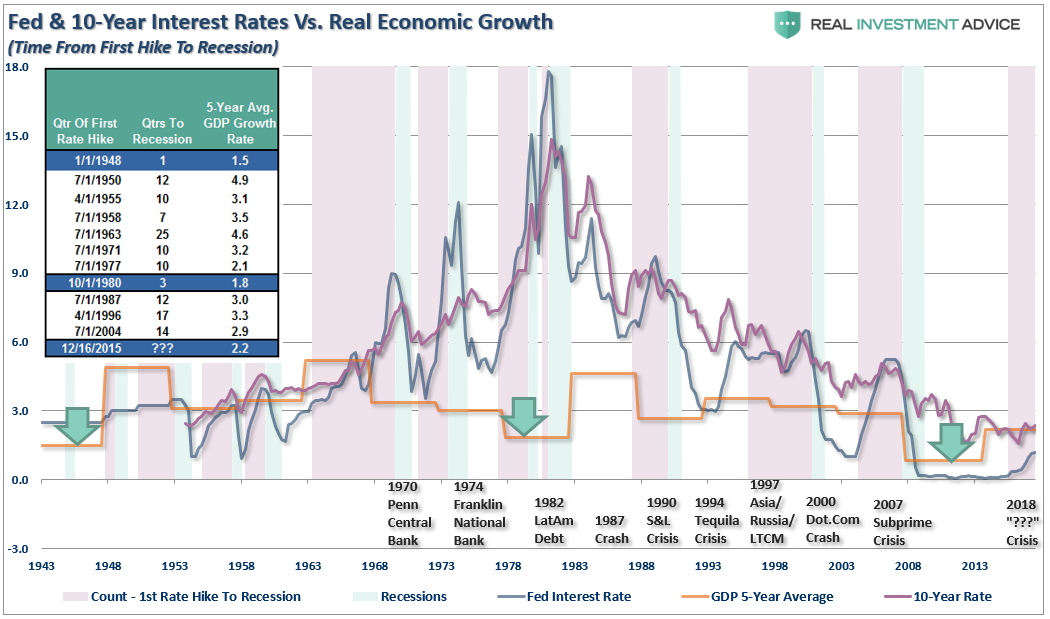
The general consensus continues to be the markets have entered into a “permanently high plateau,” or an era in which asset price corrections have been effectively eliminated through fiscal and monetary policy. The lack of understanding of economic and market cycles was on full display Monday as Peter Navarro told investors to just “buy the dip.”
“I’m thinking the smart money is certainly going to buy on the dips here because the economy is as strong as an ox.”
I urge you not to fall prey to the “This Time Is Different” thought process.
Despite the consensus belief that global growth is gathering steam, there is mounting evidence of financial strain rising throughout the financial ecosystem, which as I addressed previously, is a direct result of the Fed’s monetary policy actions. Economic growth remains weak, wages are not growing, and job growth remains below the rate of working age population growth.
While the talking points of the economy being as “strong as an ox” is certainly “media friendly,” The yield curve, as shown below, is telling a different story. While the spread between 2-year and 10-year Treasury rates has not fallen into negative territory as of yet, they are certainly headed in that direction.
(Click on image to enlarge)
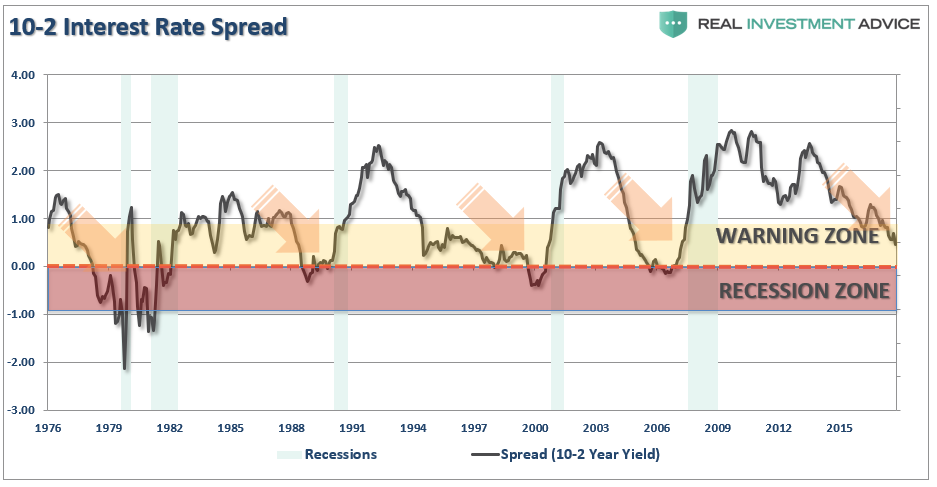
This is an important distinction. The mistake that most analysts make in an attempt to support a current view is to look at a specific data point. However, when analyzing data, it is not necessarily the current data point that is important, but the trend of the data that tells the story. Currently, the trend of the yield curve is highly suggestive of economic growth not being nearly as robust as the mainstream consensus believes.
Furthermore, economic cycles are only sustainable for as long as excesses are being built. The natural law of reversions, while they can be suspended by artificial interventions, cannot be repealed. In a consumer based economy, where 70% of economic growth is driven by consumption, you have to question both what is driving consumer spending and how are they funding it. Both of those answers can be clearly seen in the data and particularly in those areas which are directly related to consumptive behaviors.
Stephanie Pomboy recently had an interview with Barron’s magazine in which she made several very salient points as it relates to current monetary policy and the next crisis. To wit:
” In January, the savings rate went from 2.5% to 3.2% in one month—a massive increase. People look at the headline for spending and acknowledge that it’s not fabulous, but they see it as a sustainable formula for growth that will generate the earnings necessary to validate asset price levels.”
Unfortunately, the headline spending numbers are actually far more disturbing once you dig into “where” consumers are spending their dollars. As Stephanie goes on to state:
“When you go through that kind of detail, you discover that they are buying more because they have to. They are spending more on food, energy, health care, housing, all the nondiscretionary stuff, and relying on credit and dis-saving [to pay for it]. Consumers have had to draw down whatever savings they amassed after the crisis and run up credit-card debt to keep up with the basic necessities of life.”
(Click on image to enlarge)

When a bulk of incomes are diverted to areas which must be purchased, and have very little of a “multiplier effect”through the economy, spending on discretionary products or services becomes restricted. The mistake the Federal Reserve, and theAdministration, are currently making is by hitting consumers where they have the LEAST ability to compensate – interest payments and the items required for daily living like food and energy through tariffs.
Despite the recent “windfall” from tax reform, corporations aren’t “sharing the wealth” as consumption trends remain weak. When revenue, what happens at the top line of the income statement, remains weak, corporations continue to opt for share buybacks, wage suppression and accounting gimmicks to fuel bottom lines earnings per share. The requirement to meet Wall Street expectations to support share prices is more important to the “C-suite” executives than being benevolent to the working class.
(Click on image to enlarge)
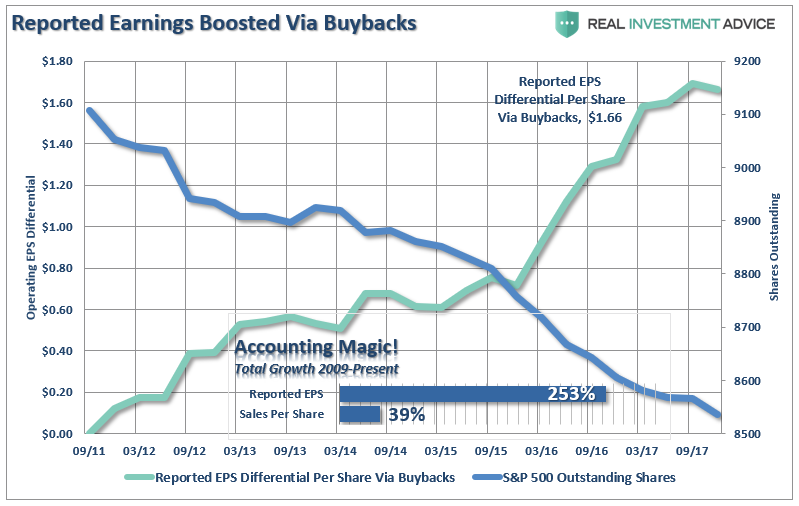
But if that all sounds very familiar, it’s because it is. As I penned previously in “Consumer Credit & The American Conundrum:”
“Therefore, as the gap between the ‘desired’ living standard and disposable income expanded, it led to a decrease in the personal savings rates and increase in leverage. It is a simple function of math. But the following chart shows why this has likely come to the inevitable conclusion, and why tax cuts and reforms are unlikely to spur higher rates of economic growth.”
What the chart below shows is the differential between the standard of living for a family of four adjusted for inflation over time. What is clear is that beginning in 1990, the combined sources of savings, credit, and incomes were no longer sufficient to fund the widening gap between the sources of money and the cost of living. With surging health care, rent, food, and energy costs, that gap has continued to widen to an unsustainable level which will continue to impede economic rates of growth.
(Click on image to enlarge)
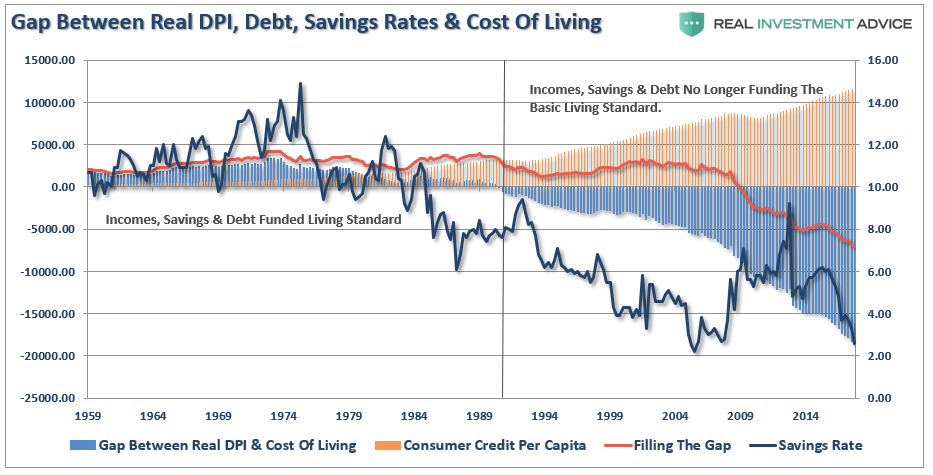
The Fed Will Do It Again
While it is currently believed that Central Bankers now have everything “under control,” the reality is they likely don’t. It is far more likely one of following two conclusions is more accurate.
-
The Fed is absolutely aware the economy is closer to the next recession than not. They also know that hiking interest rates in the current environment will likely accelerate the next downturn. However, the “lesser of two evils” is to face the recession with the Fed funds rate as far from zero as possible, or;
-
The Fed believes the economic data is indeed trending stronger and are overly confident in their ability to guide the U.S. economy into a “Goldilocks” type scenario where they can control inflationary pressures and growth rates to sustain a lasting economic cycle.
I agree with Stephanie’s point on how the next crisis will begin:
“Fed tightening continues to ratchet up and turns the screws on households and speculative-grade corporations, and the markets begin to anticipate more defaults, and reprice credit risk.”
Credit risk is already on the rise as consumers are much more sensitive to changes in rates. As the Fed continues to hike rates the negative impact on households will continue to escalate which is already showing up in credit card delinquencies.
(Click on image to enlarge)
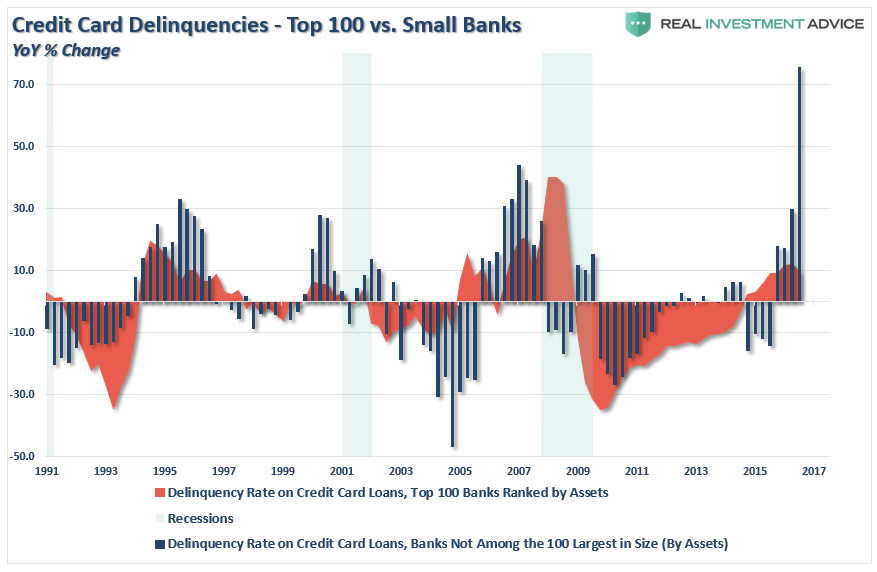
Of course, it isn’t just credit card debt that is the problem. Subprime auto loans are pushing record levels as consumers have been lured into “cars they can’t afford” through low-rates and extended terms.
(Click on image to enlarge)
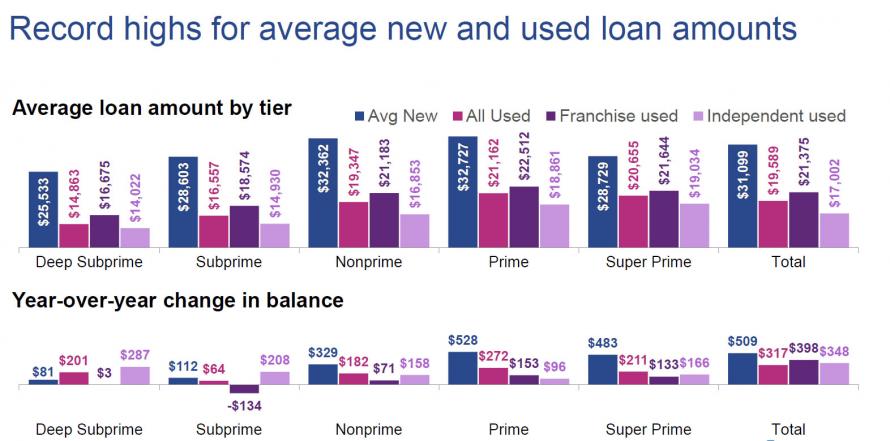
Consumers have also completely forgotten the last financial crisis and have once again turned to cashing out equityin homes to make ends meet.
(Click on image to enlarge)
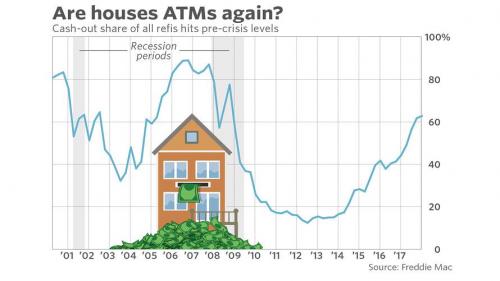
Eventually, since a lot of this debt has been bundled up and sold off in the fixed income markets, this all ends badly when, as Stephanie states, the markets begin to reprice risk across the credit spectrum. As shown, when the spreads on bonds begin to blow out, bad things have occurred in the markets and economy.
(Click on image to enlarge)
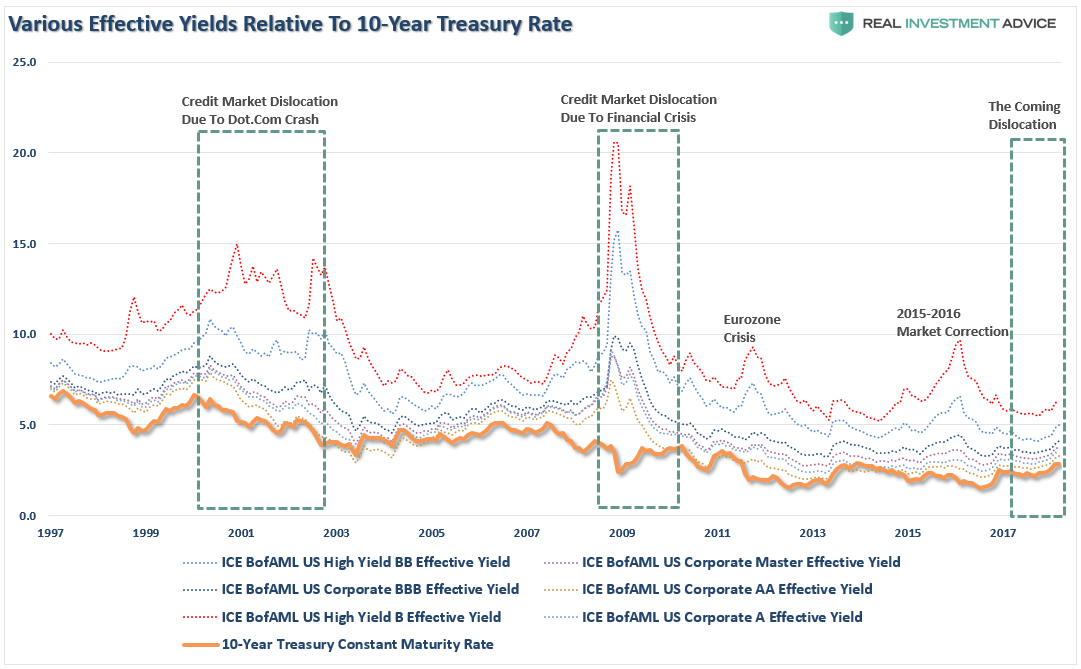
For the Federal Reserve, the next “financial crisis” is already in the works. All it takes now is a significant decline in asset prices to spark a cascade of events that even monetary interventions may be unable to stem. As stock prices decline:
- Consumer confidence falls further eroding economic growth
- The $4 Trillion pension problem is rapidly exposed which will require significant government bailouts.
- When prices decline enough, the record levels of margin debt are triggered which creates a liquidation cascade.
- As prices fall, investors and consumers both contract further pushing the economy further into recession.
- Aging baby-boomers, which are vastly under-saved will become primarily dependent on social welfare which erodes long-term economic growth rates.
With the Fed tightening monetary policy, and an errant Administration fighting a battle it can’t win, the timing of the next recession has likely been advanced by several months.
The real crisis comes when there is a “run on pensions.” With a large number of pensioners already eligible for their pension, the next decline in the markets will likely spur the “fear” that benefits will be lost entirely. The combined run on the system, which is grossly underfunded, at a time when asset prices are droppingwill cause a debacle of mass proportions. It will require a massive government bailout to resolve it.
But it doesn’t end there. Consumers are once again heavily leveraged with sub-prime auto loans, mortgages, and student debt. When the recession hits, the reduction in employment will further damage what remains of personal savings and consumption ability. The downturn will increase the strain on an already burdened government welfare system as an insufficient number of individuals paying into the scheme is being absorbed by a swelling pool of aging baby-boomers now forced to draw on it. Yes, more Government funding will be required to solve that problem as well.
As debts and deficits swell in coming years, the negative impact to economic growth will continue. At some point, there will be a realization of the real crisis. It isn’t a crash in the financial markets that is the real problem, but the ongoing structural shift in the economy that is depressing the living standards of the average American family. There has indeed been a redistribution of wealth in America since the turn of the century. Unfortunately, it has been in the wrong direction as the U.S. has created its own class of royalty and serfdom.
The issue for future politicians won’t be the “breadlines” of the 30’s, but rather the number of individuals collecting benefit checks and the dilemma of how to pay for it all.
The good news, if you want to call it that, is that the next “crisis,” will be the “great reset” which will also make it the “last crisis.”
Disclosure: The information contained in this article should not be construed as financial or investment advice on any subject matter. Real Investment Advice is expressly disclaims all liability in ...
more



Sobering look at the trend for main street.